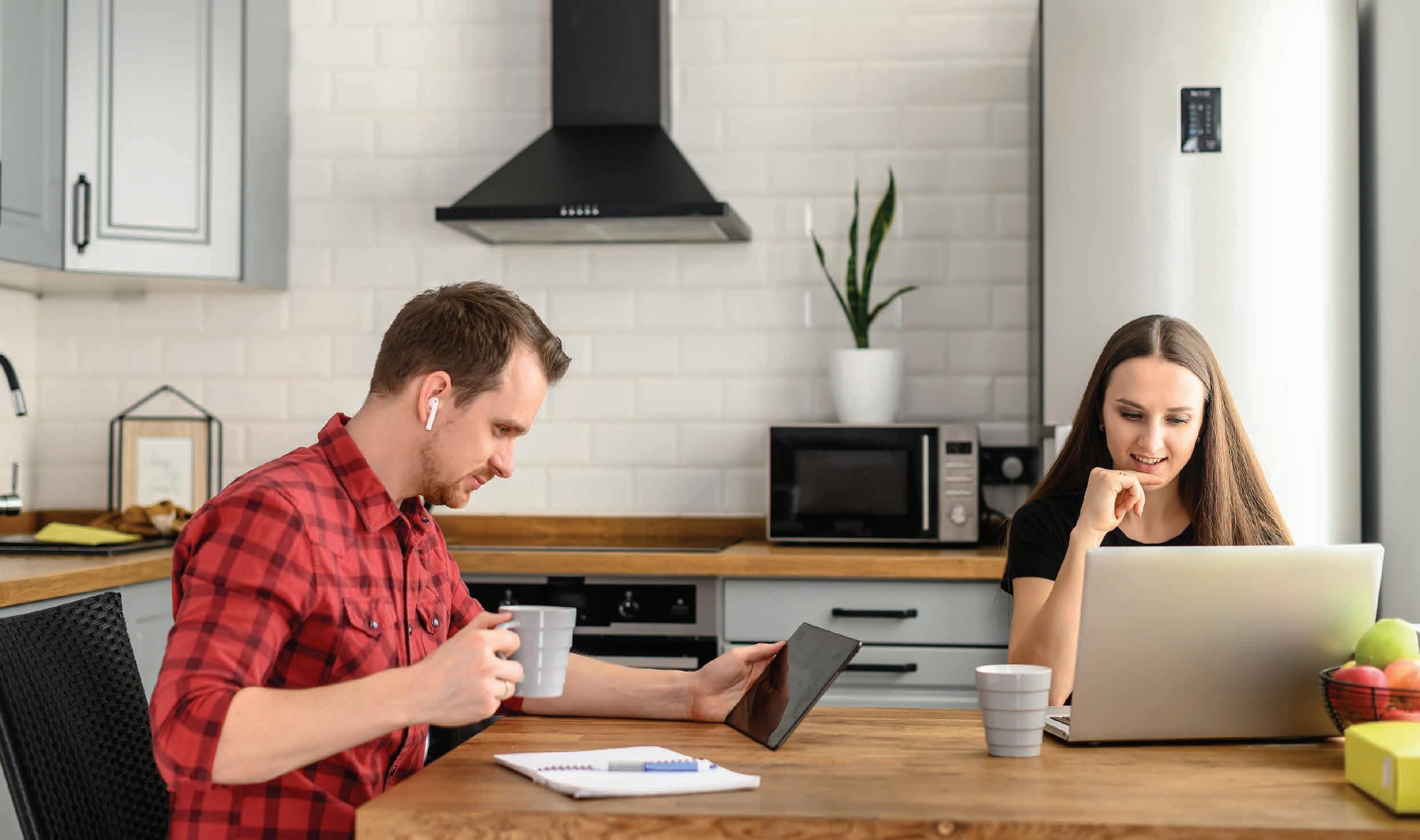
6 minute read
Flexible working. It worked during COVID: Why shouldn’t we do it now? By Marissa Mackie
Flexible working. It worked during COVID: Why shouldn’t we do it now?
MARISSA MACKIE, CHAIR, WOMEN LAWYERS COMMITTEE
Advertisement
The last year saw the profession being forced to embrace flexible working arrangements. There was no other way around it. We all quickly had to learn how to navigate new technologies, children asking for a snack mid-hearing and learning how to turn off a cat filter.
The concept of flexible working arrangements existed a long time preCOVID but it has historically been a difficult thing to come to terms with. Whilst the ‘new necessary’ enabled firms to realise that it can be done, the true benefits of flexible working for a business may not have been truly visible when navigating a period of uncertainty, economic downturn and not having established practices and procedures in place. Even for those firms with existing flexible-working practices, having every single staff member working remotely was a challenge.
The pandemic has given us an opportunity, though, to overcome the fear that many employers may have held about trusting their staff to work remotely. It has also overcome the notion that flexible working arrangements impact on morale and firm culture when people become disconnected from the office. Research has shown that flexible working arrangements can not only result in improved productivity and retention but also enable firms to create a more diverse and inclusive culture.
What’s in it for employers you may ask? PRODUCTIVITY
Working in a general office environment can come with distractions. Phone calls, meetings, people dropping in to see how your weekend was. It is often difficult, particularly in the emerging trend of open plan working, to concentrate on more complex tasks. The ability to work from home has given employees the opportunity to work without distraction, resulting in more efficient and often higher-quality work.
Numerous studies have revealed that flexible working arrangements have led to improved productivity and revenue generation.1 It can also be seen to promote creativity, particularly when away from the office environment.2
And one of the most basic principles: the ability to work from home saves time on the daily commute, not only providing additional time to get more work done, but avoiding the stress associated with peak hour traffic, which never puts anyone in a good mood!
LOWERING COSTS
It goes without saying that having fewer people in the office reduces the overheads a firm needs to pay in respect of office space and running costs relating to electricity, telecommunications and printing. A firm who embraces flexible working for all its employees, whether it involves staggering start times and days in the office, could enable it to reduce its office footprint.
The financial benefits aren’t small either. Case studies have demonstrated savings of up to 4% of a business’ net income and the ‘FlexiWork’ Calculator available on the Victorian Government website can assist firms in ascertaining the potential savings.3
It has also been shown to reduce the level of absenteeism in a workplace. Specifically in the current climate where a simple cough may prevent someone from coming into the office but they still have the ability to work from home.
RETENTION AND NEW TALENT
The ability to work flexibility, particularly in the legal profession, has generally been viewed as a privilege, not a right.4 Most employees who have been given an opportunity to work flexibly, tend to want to prove their worth and are more committed to both working harder and staying with their employer.
Offering flexible working arrangements also opens up opportunities for recruitment of a wider pool of candidates, of all genders and ages. The younger generation particularly have embraced flexible working. The Deloitte 2017 Millennial Survey,5 noted that “flexible working continues to encourage loyalty and make a significant contribution to business performance”.
INCLUSIVITY
As will be seen from the other articles in this edition of the Bulletin, flexible working isn’t just for women and it’s
no longer only about accommodating parents, but surprisingly (or not), there still appears to be a stigma against flexible working for males, with research showing that men are twice as likely as women to have requests for flexible working arrangements rejected.6
Both men and women feel uncomfortable in seeking flexible working arrangements for fear they won’t be “seen” as committed to their employer or careerminded. One lesson that COVID has taught us, is that is not the case.
Encouraging and enabling flexibility for all employees promotes an inclusive working culture which in turn leads to increased creativity, higher job satisfaction and employee morale. It enables firms to become an “employer of choice” and will also go a long way to reducing the gender pay gap.

PUBLIC IMAGE
One of the biggest issues we have had to face during COVID is trying to juggle both our work and personal lives. We’ve seen news articles about family members ‘zoom-bombing’ meetings and have dealt with the difficulties of homeschooling while responding to emails. But those issues can also be seen as a benefit, particularly for those dealing with clients who perceive lawyers in a certain light. It shows us as humans, it shows us as authentic. And that can only do wonders to rebuild public confidence in the profession. WHAT DO I NEED TO DO TO IMPLEMENT FLEXIBLE WORKING IN MY FIRM?
Whilst we have all had a ‘trial run’ at working remotely, having some basic guidelines in place will ensure it is a beneficial experience for both employers and employees.
Some of the key matters to consider in implementing a work from home policy include: • Communication – what platform works best? When is it easy for teams to catch up? Are we checking in too much or too little? Should we interrupt when ‘do not disturb’ is on?; • Work hours – when do we expect team members to be online and available?
How long should it take to respond to an email? • Work, health and safety – are there are any risks and hazards preventing employees from working at home that could give rise to a workers’ compensation claim? Particularly mental health issues? Could a work from home checklist be implemented to alleviate these issues? • Technology – do my staff have the tools to do their job properly no matter where they are?
The best way to consider these matters? Talk to your employees. Find out what they want and what works best. For those who don’t know where to start, the Diversity Council of Australia has a useful resource, called ‘Future-Flex’ which encourages employers to involve their employees in discussions about workplace flexibility.7
Remember, flexible working isn’t just about giving employees the ability to work from home…or the local café, in the car, or the beach (the latter is my go to!). Flexible working encompasses so much more. Whether it’s a four-day work week or a change in start and finish times, most importantly it’s about trust and open lines of communication to understand what works best for you and your staff.
Marissa Mackie is a barrister at Anthony Mason Chambers. B
Endnotes 1 https://www.wgea.gov.au/flexiblework#:~:text=Improvements%20in%20 productivity,to%20improved%20profits%20 for%20businesses. 2 https://www.abc.net.au/news/2020-02-06/prosand-cons-of-working-from-home/11902982. 3 https://www.vic.gov.au/case-study-flexible-workreduces-gender-pay-gap-and-saves-money. 4 For more information on employer obligations to provide flexible working arrangements please visit https://www.fairwork.gov.au/employeeentitlements/flexibility-in-the-workplace/flexibleworking-arrangements. 5 https://www2.deloitte.com/content/dam/
Deloitte/global/Documents/About-Deloitte/ gx-deloitte-millennial-survey-2017-executivesummary.pdf. 6 https://www.abc.net.au/news/2016-02-03/ men-more-likely-to-have-flexible-work-requestsknocked-back/7137208. 7 https://www.dca.org.au/research/project/futureflex-mainstreaming-flexibility-design-retail-guide










